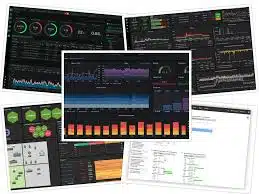- Importance of Monitoring and Observability
- Key Components of Monitoring Tools
- Diving Deeper: Observability Tools
- Integrating Monitoring and Observability
- Challenges and Considerations
- The Future of Monitoring and Observability
- Conclusion

In today’s fast-paced digital landscape, maintaining optimal performance and uptime of Linux infrastructure is paramount. The complexity of modern systems requires robust solutions to monitor and observe various components effectively. Monitoring and observability tools play a crucial role in identifying performance bottlenecks, ensuring security, and facilitating smooth operations.
Importance of Monitoring and Observability
Monitoring provides real-time insights into system performance, helping IT teams detect anomalies before they escalate into significant issues. Meanwhile, observability allows teams to understand the internal state of the system based on the data it produces. Both practices are essential for maintaining a healthy infrastructure, mitigating downtime, and enhancing user experience.
Key Components of Monitoring Tools
1. Metrics Collection
Metrics are quantitative data points that provide insights into various aspects of system performance, including CPU usage, memory consumption, and disk I/O. Tools like Prometheus and Grafana excel in collecting and visualizing this data, allowing engineers to monitor system health in real time.
2. Log Management
Logs are invaluable for troubleshooting and debugging. Solutions like ELK Stack (Elasticsearch, Logstash, and Kibana) enable the aggregation and analysis of log data, providing valuable context for issues that arise in the system.
3. Alerting and Notifications
An effective monitoring system must include alerting mechanisms to notify teams of significant changes in system status. Tools like PagerDuty or Slack integrations with monitoring solutions keep teams informed and responsive to anomalies.
Diving Deeper: Observability Tools
While monitoring gives a surface-level view of system performance, observability takes it a step further by allowing teams to perform deep dives into system behavior. Observability tools focus on collecting data not just to identify issues, but to provide insights into how systems respond under various conditions.
1. Distributed Tracing
Understanding the journey of requests through various services is crucial for diagnosing performance issues in microservices architectures. Tools like Jaeger and Zipkin allow for distributed tracing, helping teams visualize and optimize request flows.
2. Service Mesh
In a microservices environment, a service mesh like Istio can enhance observability by managing service-to-service communication. This architecture provides in-depth metrics and control, making it easier for teams to monitor service interactions.
3. Advanced Analytics
Modern observability tools leverage machine learning and sophisticated analytics to predict potential outages and performance issues. Solutions such as New Relic and Dynatrace provide AI-driven insights, enabling teams to proactively address problems before they impact users.
Integrating Monitoring and Observability
For effective management of Linux infrastructure, integrating monitoring and observability tools is essential. A combined approach provides comprehensive visibility, ensuring that teams can react swiftly to performance degradation and potential failures. This integration helps unify data from various sources, streamlining the troubleshooting process.
Challenges and Considerations
Despite the benefits, implementing these tools does come with challenges. Overhead management, data volume, and alert fatigue are common issues that organizations face. It’s critical to balance the granularity of data captured with the resource costs involved. Regularly reviewing and fine-tuning alerting thresholds can mitigate alert fatigue and improve team focus.
The Future of Monitoring and Observability
As infrastructure continues to evolve, so too will monitoring and observability tools. The rise of cloud-native applications and serverless architectures presents new challenges and opportunities. Tools that adapt to these changes, offering seamless integration and real-time insights, will lead the charge in maintaining robust Linux infrastructure.
Conclusion
Investing in effective monitoring and observability tools is crucial for organizations operating within the complexities of modern Linux infrastructure. By leveraging the right technologies and strategies, teams can enhance performance, improve reliability, and ensure that they remain responsive to the needs of their users. Adopting a comprehensive monitoring and observability framework not only enables quick detection of issues but also enriches the overall understanding of system dynamics, fostering an agile and resilient IT environment.